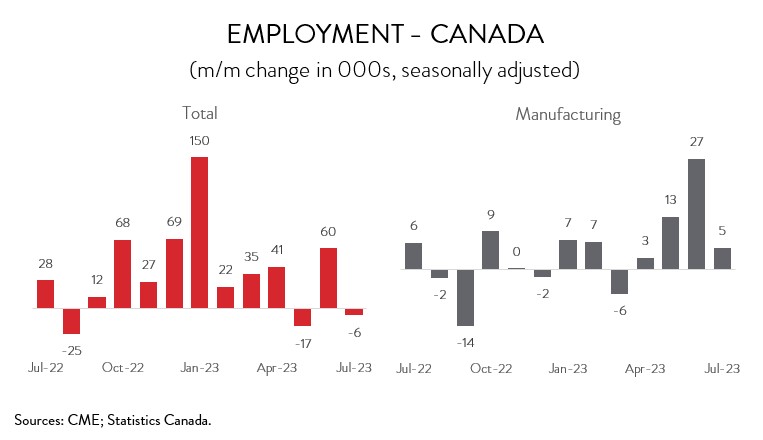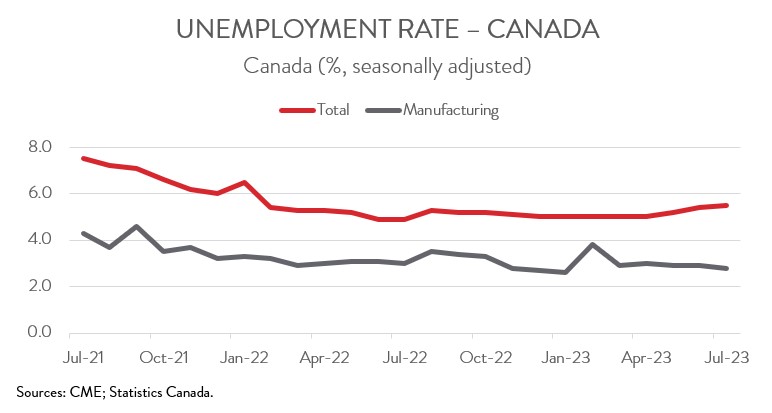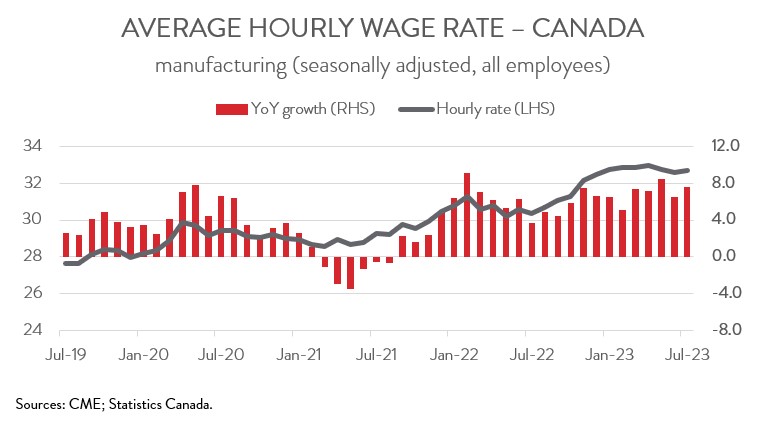Labour Market Trends
Labour Market Trends
July 2023
Canadian Labour Market Showing Signs of Cooling, But Manufacturers Add Jobs for Fourth Straight Month
HIGHLIGHTS
- Employment fell by 6,400 (-0.0%) in July, the second modest decline in three months.
- The decrease was limited to 6 of 16 industries, led by construction, public administration, and information, culture and recreation.
- Manufacturing employment increased by 5,200 (+0.3%) to 1.841 million in July, the fourth consecutive monthly gain and the highest level since December 2008.
- The headline unemployment rate inched up 0.1 percentage points to 5.5% in July, while the jobless rate in manufacturing ticked down 0.1% percentage points to 2.8%.
- Year-over-year wage growth in the manufacturing sector accelerated to 7.6% in July.
- Total employment was down in 6 of 10 provinces, with Manitoba and Saskatchewan posting the biggest proportional declines. Job gains in manufacturing were concentrated in Ontario and Alberta.
- While the labour market is showing signs of cooling, a reacceleration in wage growth will concern the Bank of Canada. Analysts are split on whether the Bank will stand pat at its meeting next month or hike interest rates one more time.
EMPLOYMENT DIPS SLIGHTLY IN JULY
Employment fell by 6,400 (-0.0%) in July, the second modest decline in three months. The underlying details of the report were not quite as weak as the headline figure, as full-time work eked out a small gain (+1,700) and hours worked inched up 0.1%.

The decrease in employment was limited to 6 of 16 industries, led by construction (-44,700), public administration (-16,700), and information, culture and recreation (-15,800). These declines were partly offset by gains in health care and social assistance (+25,100), educational services (+18,800), and finance, insurance and real estate (+15,000).
While the labour market is showing signs of cooling, a reacceleration in wage growth will concern the Bank of Canada. Analysts are split on whether the Bank will stand pat at its meeting next month or hike interest rates one more time.
MANUFACTURING EMPLOYMENT POSTS FOURTH CONSECUTIVE MONTHLY GAIN
Manufacturing employment increased by 5,200 (+0.3%) to 1.841 million in July, the fourth consecutive monthly gain and the highest level since December 2008. The recent hiring spree suggests that the sector is showing some resilience despite facing numerous obstacles, including ongoing workforce challenges, sharply higher interest rates, and soft global demand. As well, it is worth noting that manufacturing employment remains about half a million below its November 2002 peak.
MANUFACTURING UNEMPLOYMENT RATE INCHES DOWN
The headline unemployment rate rose from 5.4% in June to 5.5% in July, up 0.6 percentage points from the record low of a year ago. In contrast, the jobless rate in manufacturing ticked down from 2.9% to 2.8%, only 0.2% percentage points shy of the all-time low.

WAGE GROWTH REBOUNDS
Despite the rise in the headline unemployment rate, wage growth rebounded in July. Average hourly earnings climbed 0.4% on the month, pushing up the year-over-year increase from 4.2% in June to 5.0% in July.
Wage growth also bounced back in manufacturing, a sector that continues to experience much more intense wage pressures than that of the overall economy. On a year-over-year basis, wages in the sector accelerated from 6.5% in June to 7.6% in July. The average factory worker earned $32.68 an hour in July 2023, up from $30.37 an hour in July 2022.

ONTARIO AND ALBERTA CREATE MOST NEW MANUFACTURING JOBS IN JULY
Regionally, the decrease in employment spanned 6 of 10 provinces. The biggest absolute decline was recorded in Quebec (-8,500), while the largest proportional decreases were observed in Manitoba (-6,400) and Saskatchewan (-5,700). This was Manitoba’s first decline since April 2023. On the positive side, Alberta’s economy created 11,800 jobs in July, bringing the year-over-year increase to 83,000.
In the manufacturing sector, employment was up in five provinces in July, with the gains concentrated in Ontario (+7,800) and Alberta (+3,900). These increases were partially offset by pullbacks in Quebec (-4,200) and BC (-3,600). Taking a longer-term view, Ontario’s manufacturers (+29,000) have created the most jobs over the last year, while BC’s manufacturers (-10,000) have shed the most workers.
